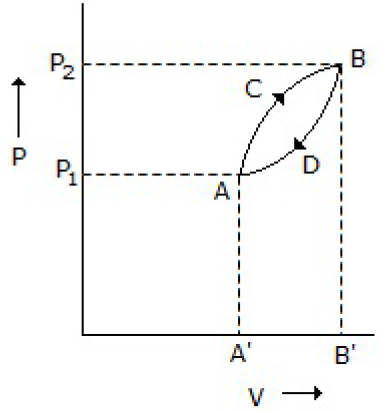Measurement of thermodynamic property of temperature is facilitated by __________ law of thermodynamics.
1st
Zeroth
3rd
None of these
Correct Answer :
B. Zeroth
Related Questions
Which of the following is not a common refrigerant?
Freon-12
Ethylene
Ammonia
Carbon dioxide
A thermodynamic system is taken from state A to B along ACB and is brought back to A along BDA as shown below in the P-V diagram. The net work done during the complete cycle is given by the area covered by

P1ACBP2P1
ACBB1A1A
ACBDA
ADBB1A1A
4 kg moles of an ideal gas expands in vacuum spontaneously. The work done is
4 J
∞
0
8 J
Critical solution temperature (or the consolute temperature) for partially miscible liquids (e.g., phenol-water) is the minimum temperature at which
A homogeneous solution (say of phenol water) is formed
Mutual solubility of the two liquids shows a decreasing trend
Two liquids are completely separated into two layers
None of these
Specific __________ does not change during phase change at constant temperature and pressure.
Entropy
Gibbs energy
Internal energy
Enthalpy
An isentropic process is carried out at constant
Volume
Pressure
Temperature
All (A), (B) and (C)
As the temperature is lowered towards the absolute zero, the value of the quantity (∂ΔF/∂T) approaches
Zero
Unity
Infinity
None of these
Pick out the correct statement.
A real gas on expansion in vacuum gets heated up
An ideal gas on expansion in vacuum gets cooled
An ideal gas on expansion in vacuum gets heated up
A real gas on expansion in vacuum cools down whereas ideal gas remains unaffected
The equation, Cp - Cv = R, is true for __________ gas.
No
Any real
Only ideal
Both (B) and (C)
Cp of a gas at its critical temperature and pressure
Becomes zero
Becomes infinity
Equals 1 kcal/kmol °K
Equals 0.24 kcal/kmol °K
Which is a state function?
Specific volume
Work
Pressure
Temperature
Chemical potential (an intensive property) of a substance is a force that drives the chemical system to equilibrium and is equal to its partial molar properties. The ratio of chemical potential to free energy of a pure substance at constant temperature and pressure is
0
1
∞
None of these
The energy of activation of exothermic reaction is
Zero
Negative
Very large compared to that for endothermic reaction
Not possible to predict
On opening the door of an operating refrigerator kept in a closed room, the temperature of the room will
Increase
Decrease
Remain same
Increase in summer and will decrease in winter
Absorption/evolution of heat during conversion of a substance from one allotropic form to another is termed as the heat of
Sublimation
Fusion
Transition
Vaporisation
Which of the following is not an intensive property?
Chemical potential
Surface tension
Heat capacity
None of these
Co-efficient of performance for a reversed Carnot cycle working between temperatures T1 and T2 (T1 > T2) is
T2/(T1 - T2)
T1/(T1 - T2)
(T1 - T2)/T1
(T1 - T2)/T2
Clausius-Clapeyron Equation gives accurate result, when the
Vapour pressure is relatively low and the temperature does not vary over wide limits
Vapour obeys the ideal gas law and the latent heat of vaporisation is constant
Volume in the liquid state is negligible compared with that in the vapour state
All (A), (B) and (C)
While dissolving a gas into a liquid at a constant temperature, the ratio of the concentration of the gas in the solution phase and in the gaseous phase is
Infinity
Unity
Constant
Negative
(1/V) (∂V/∂T)P is the mathematical expression
Joule-Thomson co-efficient
Specific heat at constant pressure (Cp)
co-efficient of thermal expansion
Specific heat at constant volume (CV)
Cv for an ideal gas
Does not depend upon temperature
Is independent of pressure only
Is independent of volume only
Is independent of both pressure and volume
A closed system is cooled reversibly from 100°C to 50°C. If no work is done on the system
its internal energy (U) decreases and its entropy (S) increases
U and S both decreases
U decreases but S is constant
U is constant but S decreases
In vapour compression refrigeration system, if the evaporator temperature and the condenser temperatures are -13°C and 37°C respectively, the Carnot COP will be
5.2
6.2
0.168
Data insufficient, can't be found out
In an ideal refrigeration cycle, the change in internal energy of the fluid is
+ve
-ve
0
Either of the above three; depends on the nature of refrigerant
In a homogeneous solution, the fugacity of a component depends upon the
Pressure
Composition
Temperature
All (A), (B) and (C)
Enthalpy of a gas depends upon its
Temperature
Mass
Volume
Pressure
Kopp's rule is used to calculate the heat capacity of
Solids
Liquids
Gases
All (A), (B) & (C)
Which of the following is not a reversible process?
Expansion of an ideal gas against constant pressure
Atmospheric pressure vaporisation of water at 100°C
Solution of NaCl in water at 50°C
None of these
With increase in temperature, the internal energy of a substance
Increases
Decreases
Remains unchanged
May increase or decrease; depends on the substance
Which of the following non-flow reversible compression processes require maximum work?
Adiabatic process
Isothermal process
Isobaric process
All require same work
